A Ranking Analysis of Geological and Engineering Factors of Historical Monuments’ Stability Response: A Case Study of Kyiv-Pechersk Lavra, Ukraine
Abstract
1. Introduction
- Collection and analysis of materials for engineering and geological research of the territory of the Kyiv-Pechersk Lavra;
- Creation of the LAVRA-GEO database on natural and technogenic indicators in the ArcGIS geographic information system;
- Development of a parametric assessment of the stability of the geological environment;
- Drawing up maps of the stability of the geological environment and the natural-technogenic system (NTS), maps of anthropogenic loads, their analysis, and interpretation of the results;
- Justification of the choice of historical buildings and criteria that determine the conditions of their operation for analysis using the hierarchical process method;
- Interpretation of data and development of recommendations for making management decisions on preservation of Lavra’s monuments.
2. Materials and Methods
2.1. Data Collection and Processing
- -
- Natural block contains data on the geological structure—quaternary deposits (genetic type and lithological composition, thickness, and strength properties), relief character (slope angles and degree of erosion ruggedness), groundwater depths, spread of exogenous geological processes, presence of fault zones of different levels, etc.;
- -
- Technogenic block consists of data on the configuration and area of buildings and structures, main engineering water-supply networks, and protective engineering structures (drainage systems of various types).
2.2. Essential Characteristics of the Study Area
2.3. Development of a Parametric (Point Integral) Assessment of the Stability of a Natural and Technogenic System
2.4. Hierarchy Method
- -
- Criteria for natural and technogenic operating conditions: soil base (SB), groundwater level (GWL), dangerous processes (DP), relief morphometry aspects (RMA), water supply networks (WSN), and underground structures (US);
- -
- Criteria for the technical condition of buildings: construction deformation (DC), land improvement system (LIS), and engineering strengthening (ES).
- -
- GWL and its changes are considered to be the most influential on the development of engineering and geological processes and the bearing capacity of the structure’s foundations based on 30 years of monitoring observations. In comparison with ES, it is estimated at 9 points according to Table 2 and so on for all comparisons;
- -
- The presence of WSNs due to constantly recurring accidents and leaks from them indirectly affects the change in GWL;
- -
- Another important factor is SB. Changes in GWL, in particular its rise due to leaks, lead to changes in the physical, mechanical, and water–physical properties of soils and foundations of structures, which leads to the development of hazardous processes, subsidence, flooding, sufosis, etc.
- -
- The distribution of soil types is influenced by the relief morphometry aspects (RMA) of the territory, determining the conditions for the spread of loess-like rocks and the formation of deluvial soils on slopes.
- -
- The presence of underground structures (US) changes the natural stress–strain state of the soil massif and serves as an obstacle to the natural discharge of groundwater;
- -
- The presence of construction deformation (DC), in particular structural cracks in buildings, indirectly indicates the development of hazardous processes in soils, uneven deformations of the building, and deterioration of the building’s structural elements;
- -
- The land improvement system (LIS), which includes paving around the building, rainwater drainage, etc., contributes to the improvement in the building’s condition to a certain extent;
- -
- Preliminary repairs or engineering strengthening (ES) bring the technical condition of the building to a higher level, but the quality of the repair or the design of the strengthening solution may not lead to this level. Compared to the WGL factor, it is estimated at 1/9.
3. Main Results
3.1. Ranking of NTS
3.2. Priority of Historical Monuments Repair Using AHP
4. Discussion
5. Conclusions
Author Contributions
Funding
Data Availability Statement
Conflicts of Interest
Correction Statement
References
- Kyiv: Saint-Sophia Cathedral and Related Monastic Buildings, Kyiv-Pechersk Lavra. Available online: https://whc.unesco.org/en/list/527/maps/ (accessed on 5 May 2024).
- Hudak, V.M.; Cherevko, I.A.; Zatserkovny, V.I.; Ostroukh, V.I.; Ilchenko, A.V. Determining of the effects of groundwater regime on the status of architectural monuments of Kyiv-Pechersk Lavra. In Geoinformatics: Theoretical and Applied Aspects; European Association of Geoscientists & Engineers: Kyiv, Ukraine, 2020; Volume 2020, pp. 1–5. [Google Scholar] [CrossRef]
- Kril, T.; Shekhunova, S.; Cherevko, I. Identification of Potentially Unstable Areas by Engineering and Geological Processes Monitoring and Heritage Building Deformations. In Proceedings of the 17th International Conference Monitoring of Geological Processes and Ecological Condition of the Environment, Kyiv, Ukraine, 7–10 November 2023; Volume 2023, pp. 1–5. [Google Scholar] [CrossRef]
- Institute of Geological Sciences of the NAS of Ukraine. Complex Research of the Geoecological State of Preservation of the Historical and Cultural Heritage Objects of the National Reserve “Kyiv-Pechersk Lavra” in the Conditions of Military Operations; Scientific Report; Institute of Geological Sciences of the NAS of Ukraine: Kyiv, Ukraine, 2023; 125p. [Google Scholar]
- Crevko, I.A.; Kril, T.V.; Bezrodnyi, D.A. Non-destructive methods of establishing a cause-and-effect relationship between water supply network accidents and the conditions for preserving architectural heritage. Geol. J. 2024, 3, 11–30. [Google Scholar] [CrossRef]
- Demchyshyn, M.G.; Kril, T.V. Improvement of the Engineering Protection Systems of the Kyiv-Pechersk Lavra Reserve Territory. Nauka Innov. 2019, 15, 37–51. [Google Scholar] [CrossRef]
- Koff, G.L.; Minakova, T.V.; Kotlov, F.V. Methodological Principles for Assessing Man-Made Changes in the Geological Environment of Cities; Nauka: Moscow, Russia, 1990; 196p. [Google Scholar]
- Sijing, W. Engineering Geology: Proceedings of the 30th International Geological Congress, 1st ed.; CRC Press: London, UK, 1997; Volume 23. [Google Scholar] [CrossRef]
- Safaie, S.; Stepanyan, M.; Houdijk, R.; Onur, T. National Disaster Risk Assessment; Safaie, S., Ed.; UNISDR: Geneva, Switzerland, 2017; Available online: https://www.unisdr.org/files/52828_nationaldisasterriskassessmentpart1.pdf (accessed on 15 October 2023).
- Rudko, G.I.; Adamenko, O.M.; Mishchenko, L.V. Strategic Ecological Assessment and Forecast of the State of the Environment of the Western Region of Ukraine. Volume 1. 2017. Available online: https://www.dkz.gov.ua/ua/113-strategichna-ekologichna-otsinka-ta-prognoz-stanu-dovkillya (accessed on 15 October 2023).
- Girgin, S.; Necci, A.; Krausmann, E. Dealing with cascading multi-hazard risks in national risk assessment: The case of Natech accidents. Int. J. Disaster Risk Reduct. 2019, 35, 101072. [Google Scholar] [CrossRef]
- Zhou, D.; Li, X.; Wang, Q.; Wang, R.; Wang, T.; Gu, Q.; Xin, Y. Gis-Based urban underground space resources evaluation toward three-dimensional land planning: A case study in Nantong, China. Tunn. Undergr. Space Technol. 2019, 84, 1–10. [Google Scholar] [CrossRef]
- Shekhunova, S.; Kril, T. Geological and economic risk assessment for territories of hazardous geological and technogenic processes (exemplified by Solotvyno township). Nauk. Visnyk Natsionalnoho Hirnychoho Universytetu 2022, 2, 79–85. [Google Scholar] [CrossRef]
- Sergeev, E.M. Theoretical Foundations of Engineering Geology. In Social and Economic Aspects; Nedra: Moscow, Russia, 1985; 332p. [Google Scholar]
- Trofimov, V.T. Theory and Methodology of Environmental Geology; Moscow State University Publishing House: Moscow, Russia, 1997; 368p. [Google Scholar]
- Golodkovskaya, G.A.; Eliseev, Y.B. Geological Environment of Industrial Regions; Nedra: Moscow, Russia, 1989; 220p. [Google Scholar]
- Kril, T.V. Technogenic Dynamic Influences on the Geological Environment of City (on an Example of Kyiv); Naukova Dumka: Kyiv, Ukraine, 2015; 160p. [Google Scholar]
- Noghin, V.D. A Logical Justification of the Edgeworth-Pareto Principle. Comput. Math. Math. Phys. 2002, 42, 915–920. [Google Scholar]
- Ehrenberg, A.S. The Problem of Numeracy. Am. Stat. 1981, 35, 67–71. [Google Scholar] [CrossRef]
- Franco, L.A.; Montibeller, G. Problem Structuring for Multicriteria Decision Analysis Interventions. In Wiley Encyclopedia of Operations Research and Management Science; John Wiley & Sons: Hoboken, NJ, USA, 2010. [Google Scholar] [CrossRef]
- Mardani, A.; Jusoh, A.; Zavadskas, E.K.; Cavallaro, F.; Khalifah, Z. Sustainable and Renewable Energy: An Overview of the Application of Multiple Criteria Decision Making Techniques and Approaches. Sustainability 2015, 7, 13947–13984. [Google Scholar] [CrossRef]
- Saaty, T.L. Decision making with the analytic hierarchy process. Int. J. Serv. Sci. 2008, 1, 83. [Google Scholar] [CrossRef]
- Gao, J.-P.; Xu, Z.-S.; Liu, D.-L.; Cao, H.-H. Application of the Model based on Fuzzy Consistent Matrix and AHP in the Assessment of Fire Risk of Subway Tunnel. Procedia Eng. 2014, 71, 591–596. [Google Scholar] [CrossRef]
- Hatefi, A.A.H.; Ekhtesasi, M.R. Groundwater potentiality through analytic hierarchy process (AHP) using remote sensing and geographic information system (GIS). Geopersia 2016, 6, 75–88. [Google Scholar]
- Qi, J.; Zhang, Y.; Zhang, J.; Chen, Y.; Wu, C.; Duan, C.; Cheng, Z.; Pan, Z. Research on the Evaluation of Geological Environment Carrying Capacity Based on the AHP-CRITIC Empowerment Method. Land 2022, 11, 1196. [Google Scholar] [CrossRef]
- Deng, F.; Pu, J.; Huang, Y.; Han, Q. 3D geological suitability evaluation for underground space based on the AHP-cloud model. Undergr. Space 2023, 8, 109–122. [Google Scholar] [CrossRef]
- Kolot, Y.I.; Kuzyshyna, L.P.; Kutovoi, V.Y.; Lavryk, V.F.; Marakhovskaia, Y.Y.; Selyn, Y.Y.; Solovytskyi, V.N.; Shestopalova, E.V. Geological Map of Ukrainian SSR of Scale 1:50,000. Kyiv Industrial Area; Explanatory Note in 2 Parts; Ministry of Geology of the Ukrainian SSR: Kyiv, Ukraine, 1984. [Google Scholar]
- Golub, V.P.; Petrenko, E.Y.; Polishchuk, V.I. Technical report on engineering and geotechnical investigations on the site and examination of the technical condition of the object: “Varyaz Caves of the Holy Assumption Kyiv-Pecherska Lavra on St. Lavrska in the Pecherskyi district of Kyiv” (first stage). SE VCBK 2011, 78-p. [Google Scholar]
- Zhadan, P.P.; Martynenko, M.B. Scientific and Technical Report on Engineering and Geological Surveys to Ensure Engineering Protection of the Territory of Nizhnya Lavra (in the Area of Buildings No. 71-1, 51-52) on St. Lavrska, 15 in Kyiv; Scientific Report; GEOLOG-BUD LLC: Kyiv, Ukraine, 2012; 54p. [Google Scholar]
- The Copernicus Open Access Hub. Available online: https://dataspace.copernicus.eu (accessed on 12 April 2024).
- Torokhtii, M.I. Regime Observations of the Flow Rate, Assessment of the Efficiency of Radial Horizontal Drainage on the Territory of the Holy Dormition Kiev-Pechersk Lavra; Scientific and Technical Report; Inventory Number 2-12/21-IB; M-STROY LLC: Kyiv, Ukraine, 2021; 33p. [Google Scholar]
- Science Toolbox Exploitation Platform. SNAP Download. Available online: https://step.esa.int/main/download/snap-download/ (accessed on 7 November 2023).
- Braun, A. Retrieval of digital elevation models from Sentinel-1 radar data-open applications, techniques, and limitations. Open Geosci. 2021, 13, 532–569. [Google Scholar] [CrossRef]
- ArcGIS Tutorials. Available online: https://desktop.arcgis.com/en/arcmap/latest/get-started/introduction/arcgis-tutorials.htm (accessed on 5 May 2024).
- Petrenko, O. Management of Geographic Data by Means of ArcGIS: Training Manual; Institute of Postgraduate Education of the Ukrainian National Technical University: Kyiv, Ukraine, 2016; 70p. [Google Scholar]
- Novikova, E.; Yeropunova, I.; Palamar, A. The change of coordinate system versus the area of parcels. Geod. Cartogr. 2020, 46, 26–33. [Google Scholar] [CrossRef]
- Palienko, V.P.; Barshchevskiy, M.E.; Spitsya, R.O. Development of the Project of the Geodynamic Network of the City of Kyiv for the Purpose of Monitoring and Preventing the Emergence of Emergency Landslide Situations and Deformation Processes on Engineering Structures and High-Rise Residential Buildings of the City of Kyiv; Scientific Report; Energoproekt: Kyiv, Ukraine, 2000; Volume 2. [Google Scholar]
- Starostenko, V.I.; Baran, P.I.; Barshchevsky, N.E.; Gorlitsky, B.A.; Demchishin, M.G.; Ivanchenko, E.P.; Kenbzera, A.V.; Kobolee, V.P.; Kutas, V.V.; Levashov, S.P.; et al. Kyiv: Geology and geophysics of the environment and factors adversely affecting it. Geophys. J. 2001, 23, 3–38. [Google Scholar]
- Rybin, V.F.; Kutsiba, V.A.; Terepishchiy, A.S.; Cherny, G.I.; Dzekunov, N.E.; Sokovnina, N.K.; Gavlovskii, S.A.; Skalskii, A.S.; Livshits, V.M.; Targonii, L.L. Development of Scientific Foundations and Recommendations for the Geological Protection of Historical and Architectural Monuments of Ukraine; Research Report; No. State Register. 01.9.1043890; IGN NAS of Ukraine: Kyiv, Ukraine, 1995; 172p. [Google Scholar]
- Konyashin, V.V.; Arkhipenko, O.A. Architectural Monument of National Significance “Church of the Savior on Berestov”; Technical Report on Engineering and Geological Investigations at the Restoration Site; Department of Geology and Geodesy of VKP Megabud: Kyiv, Ukraine, 2017; Volume 2, 76p. [Google Scholar]
- DSTU B V.2.1-2-96; Soils. State Standard of Ukraine: Kyiv, Ukraine, 1997; 51p.
- DBN V.1.1-45:2017; Buildings and Structures in Complex Engineering and Geological Conditions. Ministry of Regional Development, Construction, Housing and Communal Services of Ukraine: Kyiv, Ukraine, 2017; 35p.
- Ozdoeva, I. Use of integral index of engineering-geological conditions in large-scale engineering-geological zoning of urban areas. Izv. Vysših Učebnyh Zavedenij. Geol. Razved. 1981, 8, 70–73. [Google Scholar]
- Solodukhin, M.A. Engineering-Geological Surveys for Industrial and Civil Construction; Nedra: Moscow, Russia, 1985; 224p. [Google Scholar]
- Kotlov, V.F.; Koff, G.L. Methodological aspects of assessing the state of the geological environment. Eng. Geol. 1987, 1, 29–36. [Google Scholar]
- Zaikanov, V.G.; Minakov, T.B. Methodological bases of geoecological assessment of urbanized territories. Geoecology Eng. Geol. Hydrogeol. Geocryol. 1995, 5, 63–70. [Google Scholar]
- Lushchik, A.V.; Yakovlev, E.A.; Pochtarenko, V.I. Temporary Methodological Provisions for Ecological-Geological Mapping (Scale 1:50,000–1:200,000); State Committee on Geology of Ukraine, UkrGIMR, State Geoprognoz Enterprise: Kyiv, Ukraine, 1997; 99p. [Google Scholar]
- Tsotsur, E.S.; Kolegova, O.G.; Ziangirov, R.S.; Gruzdov, A.V. Mapping and analysis of technogenic impacts on city walls. Eng. Geol. 1992, 5, 98–103. [Google Scholar]
- Demchyshyn, M.G. The Current Dynamics of Slopes on the Territory of Ukraine (Engineering and Geological Aspects); Naukova Dumka: Kiev, Ukraine, 1992; 169p. [Google Scholar]
- Antonov, V.M.; Lednev, V.V.; Skrylev, V.I. Design of Buildings in Special Conditions of Construction and Operation; Publishing house of Tambov State Technical University: Tambov, Russia, 2002; 240p. [Google Scholar]
- Ivanov, P.; Berov, B.; Dobrev, N.; Krastanov, M.; Frangov, S. Principles for the assessment and mapping of integrated geological hazard in Bulgaria. Geol. Balc. 2017, 46, 103–109. [Google Scholar] [CrossRef]
- Kril, T.; Cherevko, I. Identification on Unstable (Landslide Hazard) Areas on Lavra Far-Caves Hill. In Proceedings of the Fourth EAGE Workshop on Assessment of Landslide Hazards and Impact on Communities, Lviv, Ukraine, 18–20 September 2023; Volume 2023, pp. 1–5. [Google Scholar] [CrossRef]
- Orlenko, T.; Tomchenko, O.; Lischenko, L.; Sedlerova, O. Landslide Hazard Assessment Using Radar Data in the Staiky, Rzhyshchiv Urban Hromada Ukraine. In Proceedings of the Fourth EAGE Workshop on Assessment of Landslide Hazardsand Impact on Communities, Lviv, Ukraine, 18–20 September 2023; Volume 2023, pp. 1–5. [Google Scholar] [CrossRef]
- Saaty, R.W. The analytic hierarchy process—What it is and how it is used. Math. Model. 1987, 9, 161–176. [Google Scholar] [CrossRef]
- Saaty, T.L. Fundamentals of the analytic hierarchy process. In The Analytic Hierarchy Process in Natural Resource and Environmental Decision Making; Springer: Berlin/Heidelberg, Germany, 2001; pp. 15–35. [Google Scholar] [CrossRef]
- DSTU-NB V.1.2-18:2016; Guidelines for the Inspection of Buildings and Structures to Determine and Assess Their Technical Condition. Ministry of Regional Development of Ukraine, State Standard of Ukraine: Kyiv, Ukraine, 2017; 47p.
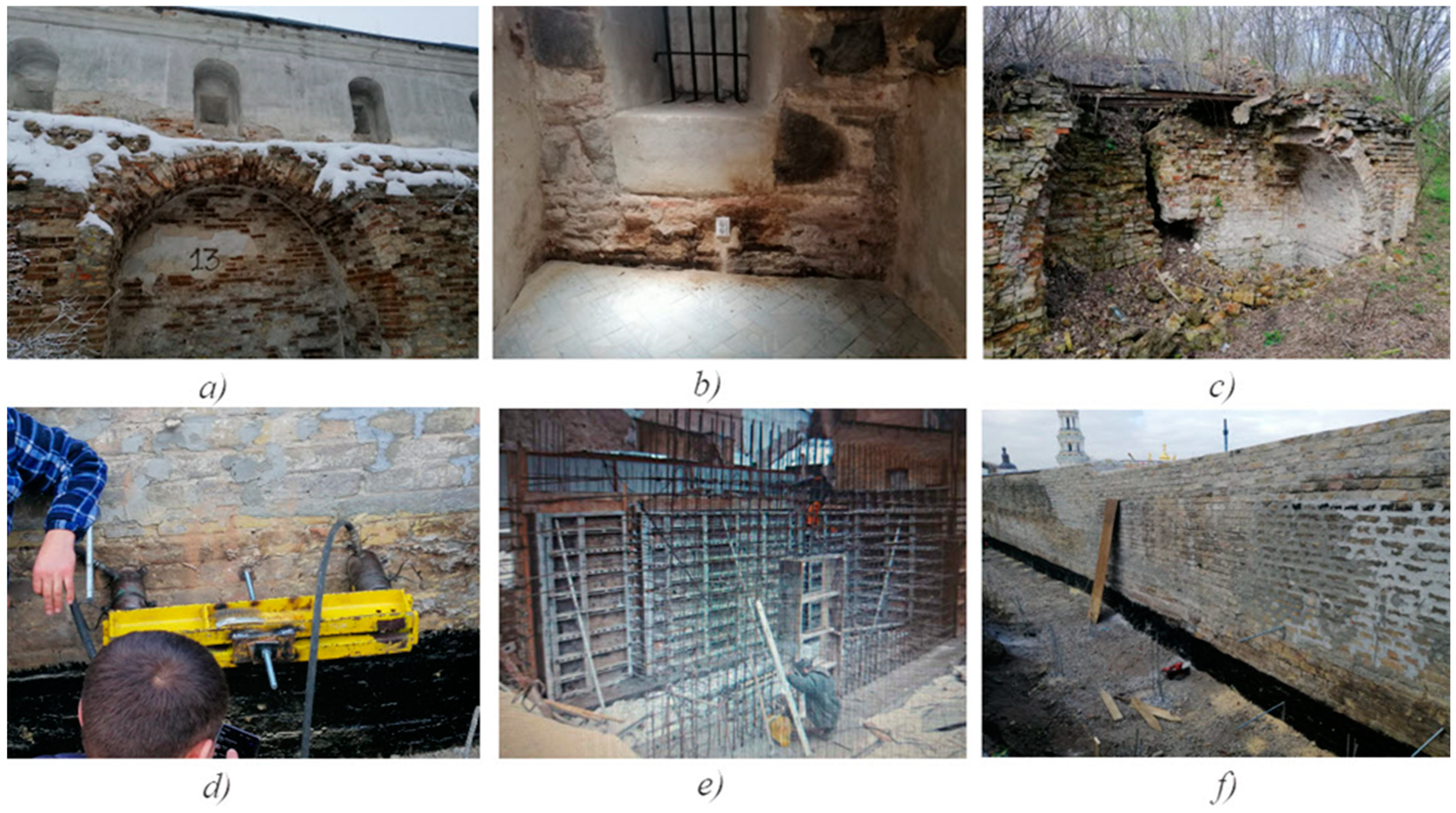
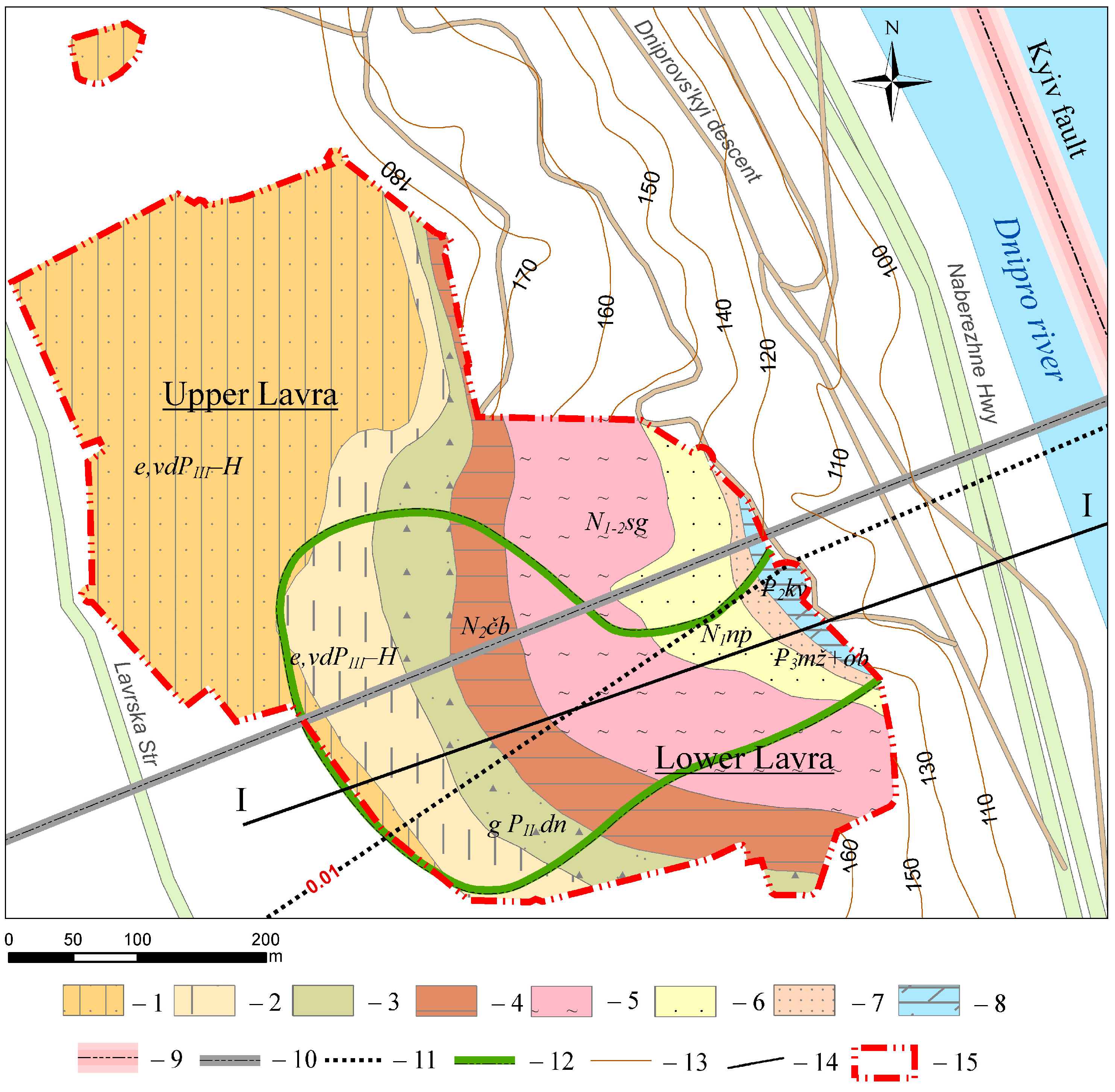
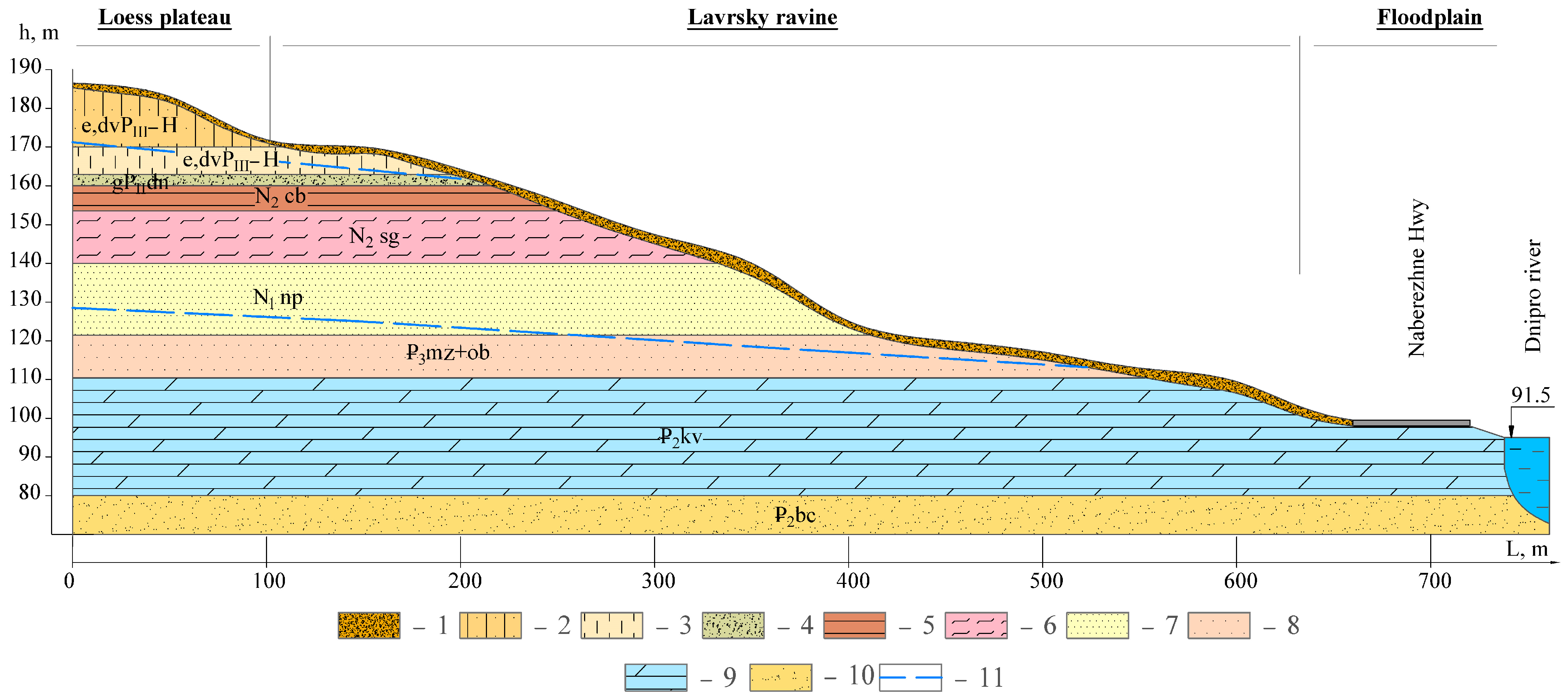
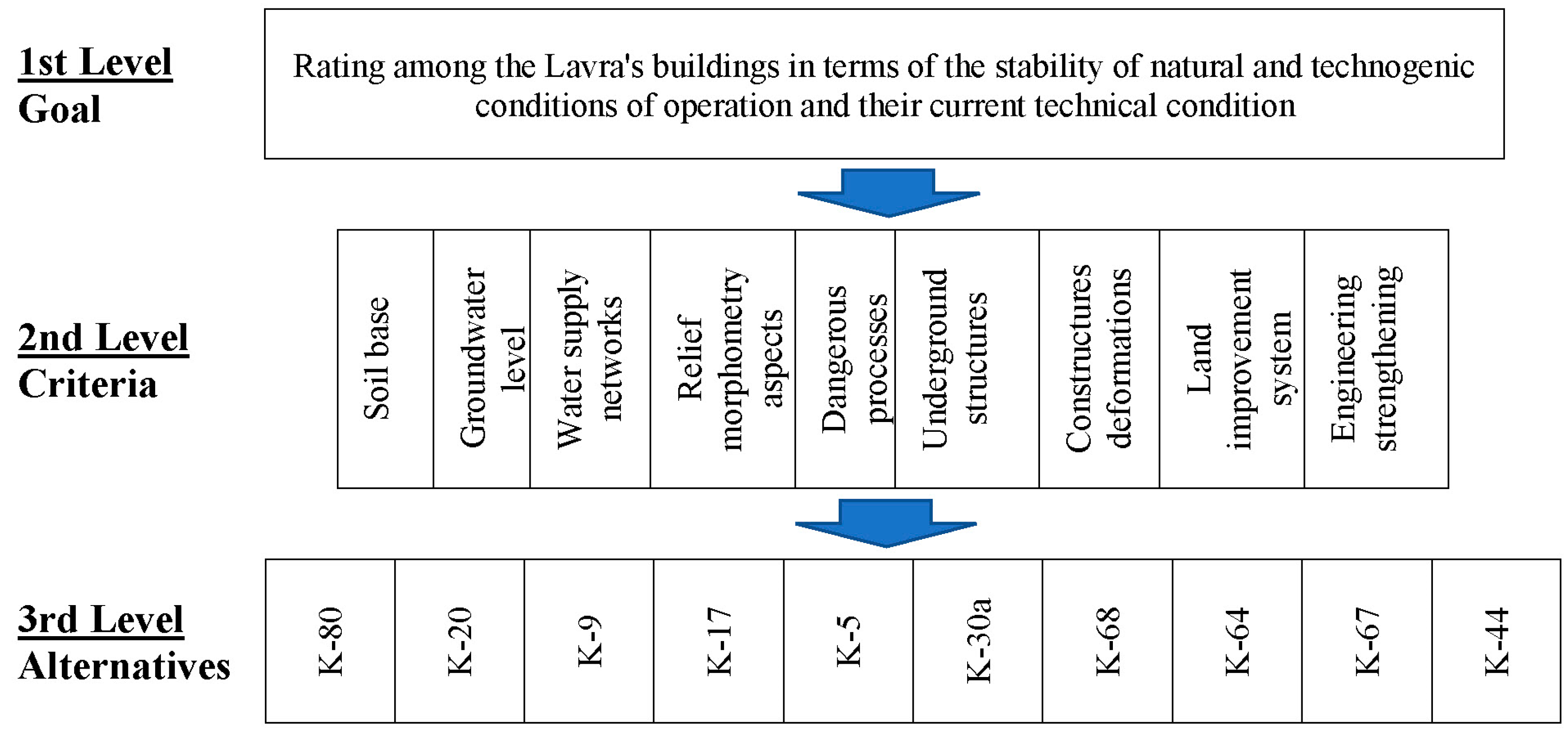
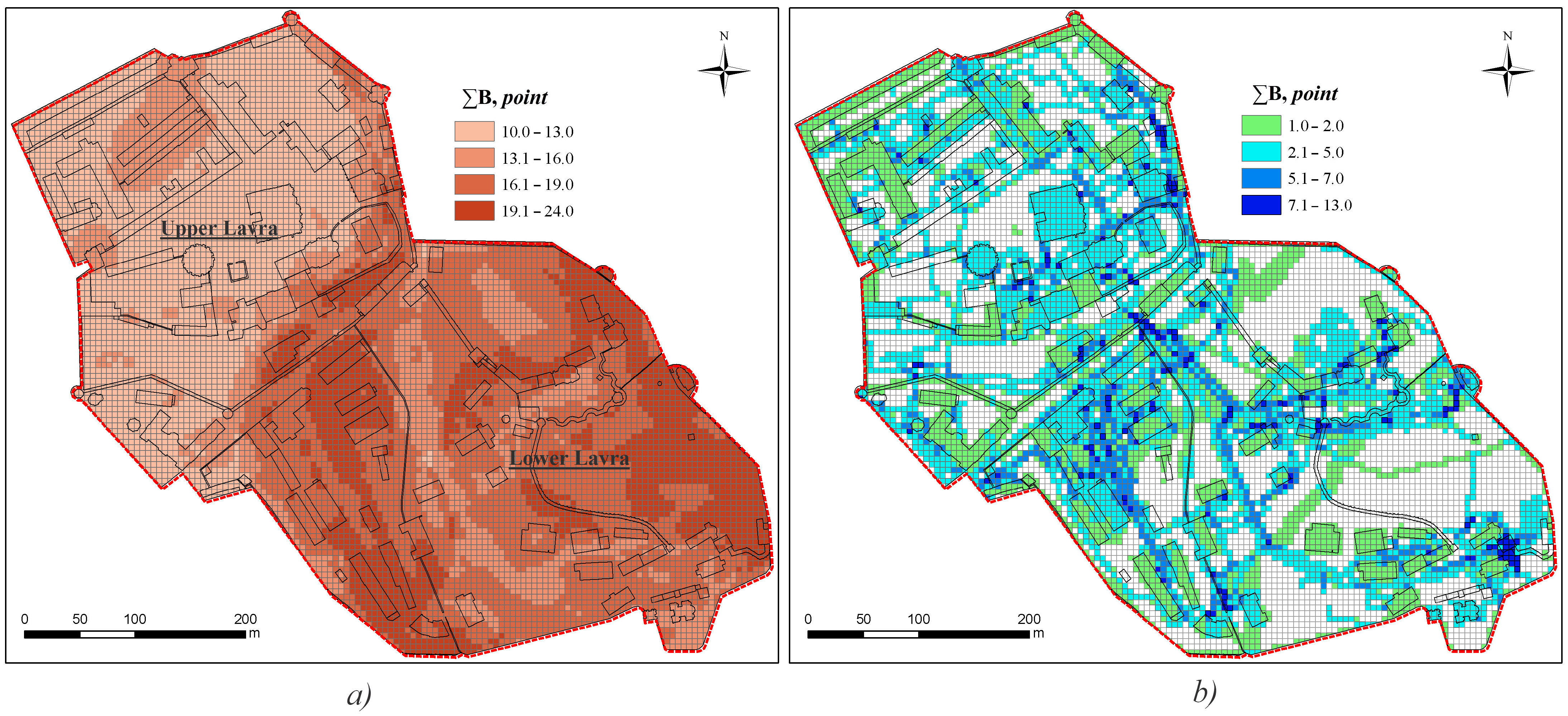
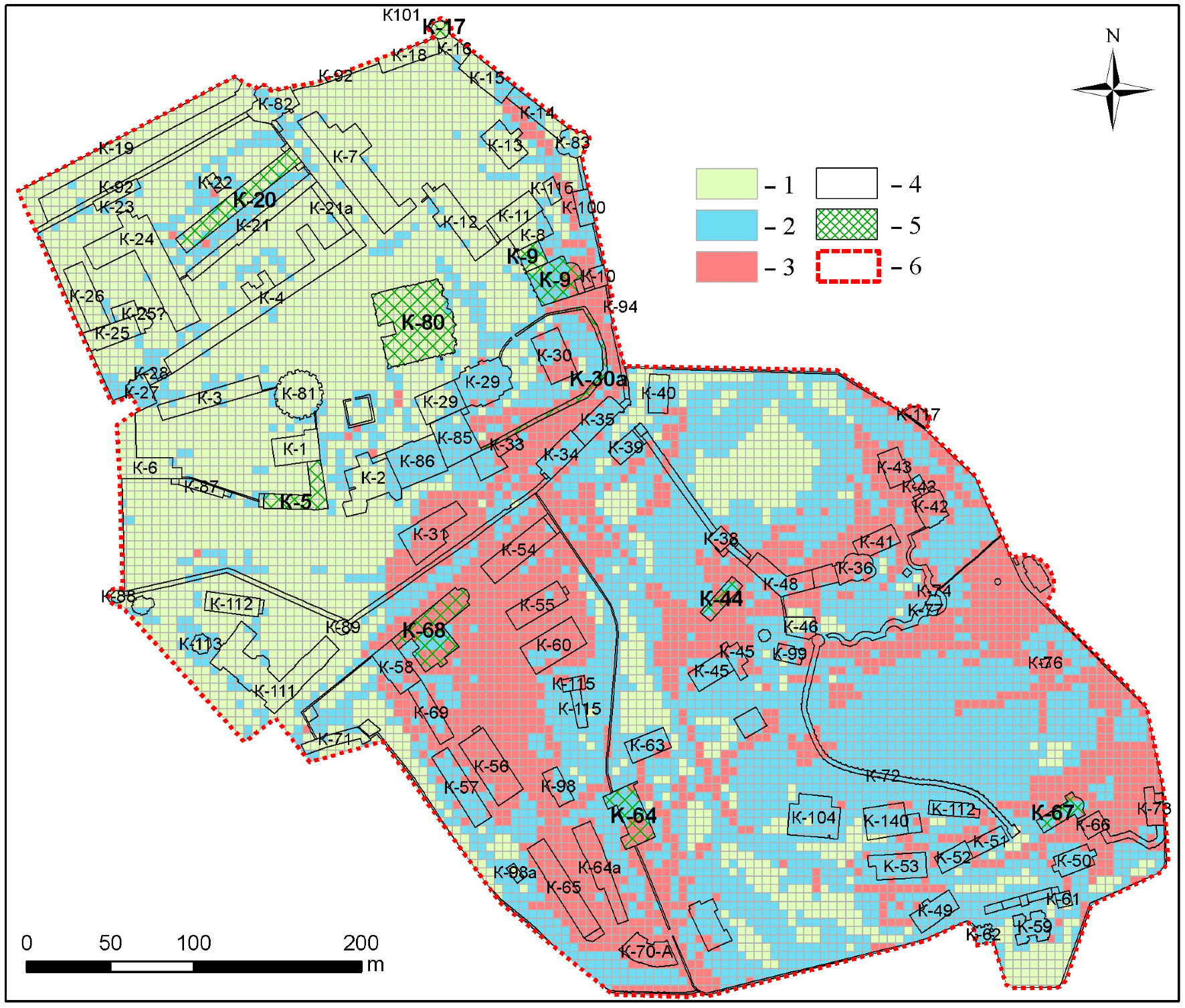
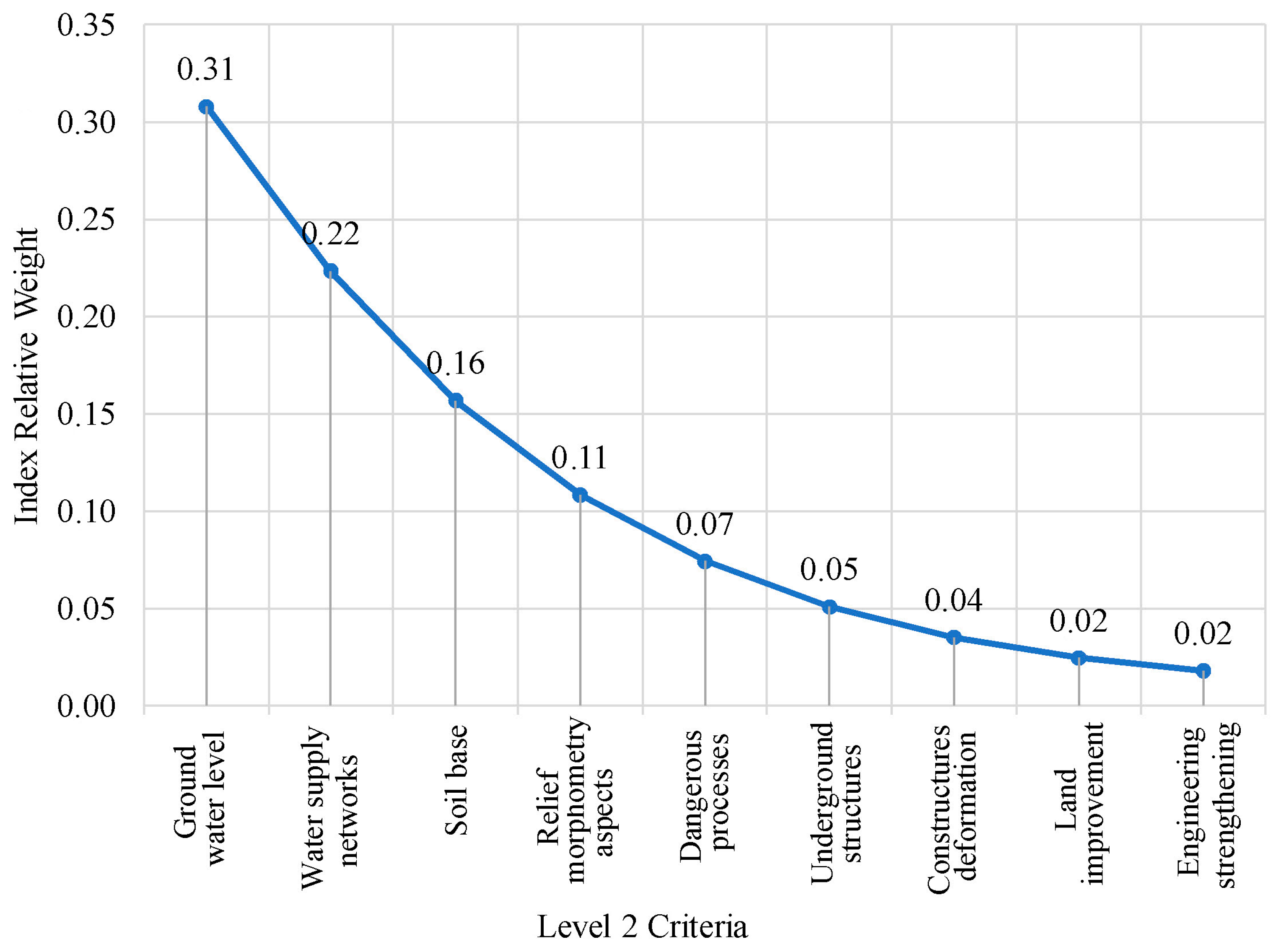
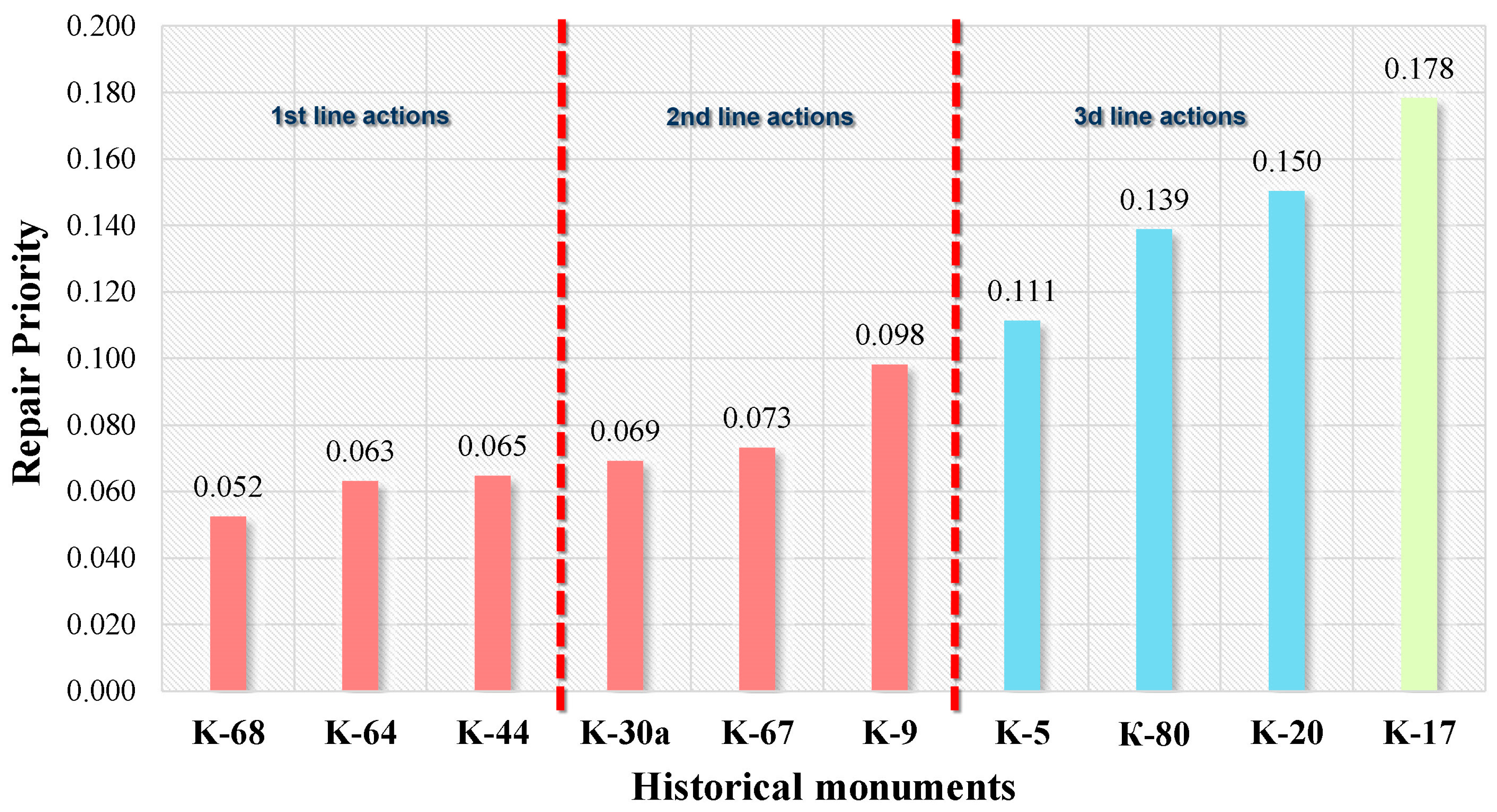
| Type of Impact | Factors | Grading Criteria for Factors | B, Point | |
|---|---|---|---|---|
| Natural (FN) | Geomorphology | Type of relief (F1) | Flat areas of floodplain terraces, moraine-glacial plains, loess plateaus | 1 |
| Slightly sloping surfaces of floodplain terraces, watershed areas | 2 | |||
| Landslide hazard areas of slopes with active development of ravines, sinkholes, low floodplain | 3 | |||
| Morphometrics (F2) | Surface slope ≥ 5°40′, density of relief ruggedness 0–2 km/km2 | 1 | ||
| Surface slope 5°40′–11°20′, density of relief ruggedness 2–3 km/km2 | 2 | |||
| Surface slope > 11°20′, density of relief ruggedness 3–4 km/km2 | 3 | |||
| Neotectonics | Presence of geodynamic activity zones (F3) | Tectonic faults are absent, average neotectonic crustal movements < 0.007 cm/km/thousand years | 1 | |
| In the vicinity of faults or nodes. Velocities of average neotectonic movements of the Earth’s crust 0.007–0.01 cm/km/thousand years | 2 | |||
| Coincidence with fault intersection nodes. Coincidence with the fault zone. Velocities of average neotectonic crustal movements of 0.01 cm/km/thousand years or more | 3 | |||
| Hydrogeological conditions | Depth of groundwater levels (F4) | >5 m | 1 | |
| 5–3 m | 2 | |||
| <3 m | 3 | |||
| Type of sediments (subsoils) | Genetic type and lithology (F5) | Hard, semi-hard unweathered clays, dense and medium dense sands, except for dusty ones, alluvial undrained deposits are represented by multi-grained sands | 1 | |
| Soft-plastic clays, watered superflood sands of the valley of the Dnipro River and its tributaries, small, medium density | 2 | |||
| Deluvial clay soils (water-saturated). Sagging soils, fluid-plastic and fluid clays | 3 | |||
| Design soil resistance, MPa (F6) | >0.25 | 1 | ||
| 0.25–0.15 | 2 | |||
| <0.15 | 3 | |||
| The thickness of technogenic sediments, m (F7) | <1 | 1 | ||
| 1–3 | 2 | |||
| >3 | 3 | |||
| Physical and geological processes and phenomena | Landslides (F8) | Absent or stabilized processes | 1 | |
| Landslide hazardous areas with the possibility of landslide formation with a depth of slope rocks of 1–3 m | 2 | |||
| Active manifestation of landslide displacements, depth of slope rocks > 3 m | 3 | |||
| Waterlogging (F9) | By surface water | 1 | ||
| Concealed flooding (rising damp) | 2 | |||
| Due to seasonal groundwater fluctuations | 3 | |||
| Subsidence in loess soils (F10) | Absent | 1 | ||
| I Type | 2 | |||
| II Type | 3 | |||
| Negative landforms by depth (F11) | Absent | 1 | ||
| Sinkholes and subsidence are emergency. Dimensions: 1–10 m in diameter, depth up to 2.5 m | 2 | |||
| Sinkholes above workings (drainage complex, water supply networks). Dimensions: 1–15 m in diameter, depth up to 10 m. | 3 | |||
| Technogenic (FT) | Stress–strain state of the soil massif | Static load from existing structures, indirectly by number of storeys (F12) | 1 | 1 |
| 2–3 | 2 | |||
| >3 | 3 | |||
| Underground facilities (F13) | Absent | 1 | ||
| Foundations to the depths < 5 m | 2 | |||
| Religious buildings (caves), at various depths; Foundations at depths of more than 5 m | 3 | |||
| Underground water supply and sewerage networks | Underground networks and utilities (F14) | Cold water networks—up to 15 °C | 1 | |
| Hot water networks—60 °C | 2 | |||
| Cold and hot water supply networks | 3 | |||
| Network density (total length per unit area) m/m2 (F15) | <0.08 | 1 | ||
| 0.08–0.28 | 2 | |||
| >0.28 | 3 | |||
| Drainage systems and groundwater drainage systems by efficiency | Drainage systems of deep laying (15–30 m) according to work efficiency: specific flow rate (q), m3/day; Specific removal (b), m3/day (F16) | q = 0.11–0.5 b = 0.001–0.016 | 1 | |
| q = 0.021–0.1 b = 0.017–0.1 | 2 | |||
| q = 0.001–0.02; b = 0.11–0.2 | 3 | |||
| Medium and shallow drainage systems (h, m) by the size of the zone of development of negative processes—L (subsidence, sufosis, etc.) (F17) | h = 1–2 m, L up to 3 m | 1 | ||
| h = 2–6 m, L up to 9 m | 2 | |||
| h > 6 m, L up to 14 m | 3 | |||
| Intensity of Relative Importance | Definition | Explanation |
|---|---|---|
| 1 | Equal importance | The elements are in equal conditions |
| 3 | Slight preference of one over another | The experience and judgement of an expert give a slight preference to one element over another |
| 5 | Significant or strong preference | The experience and judgement of an expert gives preference to one element over another |
| 7 | Significant preference | One element is given such a strong preference that it becomes practically significant |
| 9 | Very strong preference | The obvious preference of one element over another is confirmed most strongly |
| 2,4,6,8, | Intermediate decisions between two judgments (evaluations, opinions) | Used in compromise cases |
| Inverse quantities (1/2, 1/3, …, 1/9) | If when comparing elements A2 with A3, we obtain an intensity of 7; when comparing A3 with A2, we obtain 1/7—the preference is much worse | Displays the inverse of the comparison items against each other |
| Criteria, 2nd Level | Assessment Score | ||||
|---|---|---|---|---|---|
| 1 | 3 | 5 | 7 | 9 | |
| GWL | <3 m | 3–5 m | 5–10 m | 10–15 m | >15 m |
| WSN | Hot and cold water supply in emergency condition | Cold water supply in emergency condition | Hot and cold water supply | Cold water supply | Absent |
| SB | Clay soils in a moist condition | Deluvium or loess-like loam in a moist condition | Moraine sediments or clay soils | Loess soils in a dry condition | Poltava sands or sandy loams |
| RMA | Steep slopes | Edge of the slope | Slight slopes | Ravine thalwegs | Plain area |
| DP | 4 processes | 3 processes | 2 processes | 1 processes | Absent |
| US | Underground structures at a depth of 5–8 m in the immediate vicinity of buildings, caves | Drainage systems | Buildings foundations | Radial drainage | Absent |
| DC * | IV—emergency condition | III—unusable | II—satisfactory technical condition | I—normal | Visible cracks in the facing material |
| LIS | Absent | Only paving | Paving and drainage system from the roof | Paving, regulated drainage system (melt and rainwater) | Complex landscaping (paving, drainage; retaining walls) |
| ES | Bored piles | Micropiles | Silicification | External buttresses, anchorages, cages | Absent as unnecessary. |
| GWL | WSN | SB | RMA | DP | US | DC | LIS | ES | Eigenvector | ILW, 2nd Level | |
|---|---|---|---|---|---|---|---|---|---|---|---|
| GWL | 1.00 | 2.00 | 3.00 | 4.00 | 5.00 | 6.00 | 7.00 | 8.00 | 9.00 | 4.15 | 0.31 |
| WSN | 0.50 | 1.00 | 2.00 | 3.00 | 4.00 | 5.00 | 6.00 | 7.00 | 8.00 | 3.01 | 0.22 |
| SB | 0.33 | 0.50 | 1.00 | 2.00 | 3.00 | 4.00 | 5.00 | 6.00 | 7.00 | 2.11 | 0.16 |
| RMA | 0.25 | 0.33 | 0.50 | 1.00 | 2.00 | 3.00 | 4.00 | 5.00 | 6.00 | 1.46 | 0.11 |
| DP | 0.20 | 0.25 | 0.33 | 0.50 | 1.00 | 2.00 | 3.00 | 4.00 | 5.00 | 1.00 | 0.07 |
| US | 0.17 | 0.20 | 0.25 | 0.33 | 0.50 | 1.00 | 2.00 | 3.00 | 4.00 | 0.69 | 0.05 |
| DC | 0.14 | 0.17 | 0.20 | 0.25 | 0.33 | 0.50 | 1.00 | 2.00 | 3.00 | 0.47 | 0.04 |
| LIS | 0.13 | 0.14 | 0.17 | 0.20 | 0.25 | 0.33 | 0.50 | 1.00 | 2.00 | 0.33 | 0.02 |
| ES | 0.11 | 0.13 | 0.14 | 0.17 | 0.20 | 0.25 | 0.33 | 0.50 | 1.00 | 0.24 | 0.02 |
| SUM | 2.83 | 4.72 | 7.59 | 11.45 | 16.28 | 22.08 | 28.83 | 36.50 | 45.00 | 13.46 | 1.00 |
| No. | Risk Potential | Potential Consequences | Risk Management | Main Objects |
|---|---|---|---|---|
| 1 | Potentially low risk, there is no need for a risk factor accounting system | A very low probability of a hazardous event occurring, with potentially negligible consequences | No risk management measures required | Great Lavra Bell Tower K-81, Paint Tower K-17, Kushnyk Tower K-88; Assumption Cathedral |
| 2 | Potentially moderate risk, an accounting system is recommended | The possibility of a hazardous event, the potential consequences of which will require some effort to restore the previous state | Risk management measures recommended | Trinity Gate Church K-27; entrance to the Near Caves K-41; Cells K-20; Flavian Library K-5; House of the Metropolitan Choir Singers K-6; Near Cave Hill; Metropolitan’s Garden |
| 3 | Potentially high risk, a risk factor accounting system is mandatory | A high probability of a hazardous event occurring, the scale of the potential consequences of which will require significant efforts to restore the previous state | Risk management measures are mandatory | Hospital with a Church K-68; Cells K-4; Candle Factory K-64; Cells K-44, Hotel for Pilgrims K-56; Retaining Wall of the Upper Lavra K-30a, sites 1 and 13–15 of K-92 |
| GWL | WSN | SB | RMA | DP | US | SC | LIS | ES | IRW | |
|---|---|---|---|---|---|---|---|---|---|---|
| ILW (2nd Level) | 0.31 | 0.22 | 0.16 | 0.11 | 0.07 | 0.05 | 0.04 | 0.02 | 0.02 | |
| K-80 | 0.1865 | 0.0958 | 0.1413 | 0.2099 | 0.0792 | 0.0728 | 0.0886 | 0.0442 | 0.0703 | 0.139 |
| K-20 | 0.1865 | 0.0496 | 0.1413 | 0.2099 | 0.1529 | 0.3693 | 0.0886 | 0.0954 | 0.0703 | 0.150 |
| K-9 | 0.1865 | 0.0958 | 0.0303 | 0.0478 | 0.0415 | 0.0728 | 0.0335 | 0.0442 | 0.0165 | 0.098 |
| K-17 | 0.1865 | 0.1833 | 0.1413 | 0.1282 | 0.2763 | 0.1856 | 0.1634 | 0.1506 | 0.2453 | 0.178 |
| K-5 | 0.1090 | 0.0496 | 0.1413 | 0.2099 | 0.1529 | 0.0271 | 0.0335 | 0.2911 | 0.0379 | 0.111 |
| K-30a | 0.0190 | 0.1833 | 0.0768 | 0.0168 | 0.0415 | 0.0271 | 0.0136 | 0.0954 | 0.0703 | 0.069 |
| K-68 | 0.0315 | 0.0496 | 0.0303 | 0.0855 | 0.0792 | 0.0728 | 0.1634 | 0.0442 | 0.0703 | 0.052 |
| K-64 | 0.0315 | 0.0958 | 0.0303 | 0.0478 | 0.0792 | 0.0728 | 0.1634 | 0.0954 | 0.2453 | 0.063 |
| K-67 | 0.0315 | 0.1833 | 0.0202 | 0.0168 | 0.0792 | 0.0728 | 0.0886 | 0.0954 | 0.1358 | 0.073 |
| K-44 | 0.0315 | 0.0140 | 0.2468 | 0.0274 | 0.0178 | 0.0271 | 0.1634 | 0.0442 | 0.0379 | 0.065 |
Disclaimer/Publisher’s Note: The statements, opinions and data contained in all publications are solely those of the individual author(s) and contributor(s) and not of MDPI and/or the editor(s). MDPI and/or the editor(s) disclaim responsibility for any injury to people or property resulting from any ideas, methods, instructions or products referred to in the content. |
© 2024 by the authors. Licensee MDPI, Basel, Switzerland. This article is an open access article distributed under the terms and conditions of the Creative Commons Attribution (CC BY) license (https://creativecommons.org/licenses/by/4.0/).
Share and Cite
Kril, T.; Cherevko, I.; Shekhunova, S. A Ranking Analysis of Geological and Engineering Factors of Historical Monuments’ Stability Response: A Case Study of Kyiv-Pechersk Lavra, Ukraine. Buildings 2024, 14, 3152. https://doi.org/10.3390/buildings14103152
Kril T, Cherevko I, Shekhunova S. A Ranking Analysis of Geological and Engineering Factors of Historical Monuments’ Stability Response: A Case Study of Kyiv-Pechersk Lavra, Ukraine. Buildings. 2024; 14(10):3152. https://doi.org/10.3390/buildings14103152
Chicago/Turabian StyleKril, Tetiana, Iryna Cherevko, and Stella Shekhunova. 2024. "A Ranking Analysis of Geological and Engineering Factors of Historical Monuments’ Stability Response: A Case Study of Kyiv-Pechersk Lavra, Ukraine" Buildings 14, no. 10: 3152. https://doi.org/10.3390/buildings14103152
APA StyleKril, T., Cherevko, I., & Shekhunova, S. (2024). A Ranking Analysis of Geological and Engineering Factors of Historical Monuments’ Stability Response: A Case Study of Kyiv-Pechersk Lavra, Ukraine. Buildings, 14(10), 3152. https://doi.org/10.3390/buildings14103152







